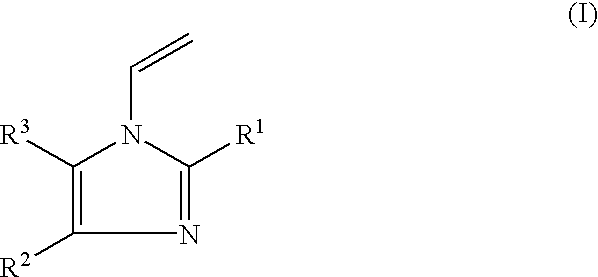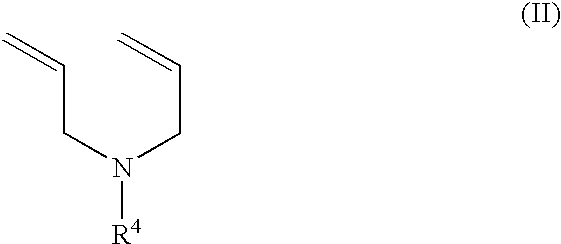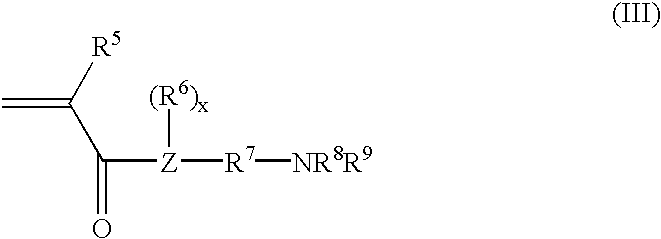Hair cosmetic agent
a hair and cosmetic technology, applied in the field of hair cosmetic agents, can solve the problems of hair loss between 40 and 50% of its tensile force, hair loss, hair damage,
- Summary
- Abstract
- Description
- Claims
- Application Information
AI Technical Summary
Problems solved by technology
Method used
Image
Examples
preparation examples
[0137] Preparation Examples Polymers
Example 1
[0138] A mixture of 48 g of 3-methyl-1-vinylimidazolium methylsulfate, 192 g of N-vinylpyrrolidone and 350 g of water was adjusted to a pH of 7.8 using 10% strength by weight sodium hydroxide solution (feed 1). 3.0 g of 2,2'-azobis-(2-methylpropionamidine) dihydrochloride and 100 g of water were used to prepare feed 2 a [sic] 2 l stirred container which was equipped with stirrer, heating, reflux condenser and metering device was charged with 300 g of water, 100 ml of feed 1 and 12 ml of feed 2, and the mixture was heated to 60.degree. C. with stirring. At this temperature, the remainder of feed 1 was metered in over the course of 4 hours, and the remainder of feed 2 over the course of 6 hours. The mixture was then stirred at this temperature for a further hour. This gave a clear, viscous polymer solution. The K value of the polymer was 300.4 (0.1% strength by weight).
example 2
[0139] A mixture of 120 g of 3-methyl-1-vinylimidazolium methylsulfate, 120 g of N-vinylpyrrolidone, 1.2 g of mercaptoethanol and 350 g of water was adjusted to a pH of 7.5 using concentrated ammonia solution (feed 1). 3.0 g of 2,2'-azobis-(2-methylpropionamidine) dihydrochloride and 100 g of water were used to prepare feed 2. A 2 l stirred container which was equipped with stirrer, heating, reflux condenser and metering device was charged with 300 g of water, 100 ml of feed 1 and 12 ml of feed 2, and the mixture was heated to 55.degree. C. with stirring. At this temperature, the remainder of feed 1 was metered in over the course of 7 hours and the remainder of feed 2 over the course of 9 hours. The mixture was then stirred at this temperature for a further one hour. This gave a clear, viscous polymer solution. The K value of the polymer was 82.3 (1% strength by weight).
example 3
[0140] A mixture of 203 g of monomer solution according to Example 1, 100 g of water and 280 g of vinyl pytrolidone, referred to below as feed 1, is adjusted to a pH of 7.5 using concentrated ammonia solution. 2 g of 2,2'-azobis(2-amidinopropane) hydrochloride and 55 g of water are used to prepare a second solution, referred to below as feed 2.
[0141] 362 g of water, 50 ml of feed 1 and 5 ml of feed 2 are heated to 75.degree. C. with stirring in a 2 l glass vessel equipped with stirrer, heating, reflux condenser and metering devices. After the intended temperature has been reached, the remainder of feed 1 is metered in over the course of four hours, and the remainder of feed 2 over the course of five hours at a constant temperature of 75.degree. C. The mixture is then stirred for a further hour at this temperature. This gives a clear, high-viscosity polymer solution. The K value of the polymer is 141.5.
PUM
| Property | Measurement | Unit |
|---|---|---|
| temperatures | aaaaa | aaaaa |
| average molecular weight | aaaaa | aaaaa |
| pH | aaaaa | aaaaa |
Abstract
Description
Claims
Application Information
 Login to View More
Login to View More - R&D
- Intellectual Property
- Life Sciences
- Materials
- Tech Scout
- Unparalleled Data Quality
- Higher Quality Content
- 60% Fewer Hallucinations
Browse by: Latest US Patents, China's latest patents, Technical Efficacy Thesaurus, Application Domain, Technology Topic, Popular Technical Reports.
© 2025 PatSnap. All rights reserved.Legal|Privacy policy|Modern Slavery Act Transparency Statement|Sitemap|About US| Contact US: help@patsnap.com



